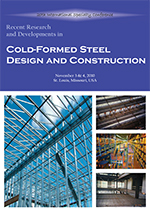Session Dates
03 Nov 2010
Keywords and Phrases
finite strip method||constrained finite strip method||boundary conditions||elastic buckling analysis||CUFSM
Abstract
The objective of this paper is to provide the theoretical background and illustrative examples for elastic buckling analysis of cold-formed steel members with general boundary conditions as implemented in the forthcoming update to CUFSM. CUFSM is an open source finite strip elastic stability analysis program freely distributed by the senior author. Although the finite strip method presents a general methodology, the conventional implementation (e.g. CUFSM v 3.13 or earlier) employs only simply-supported boundary conditions. In this paper, utilizing specially selected longitudinal shape functions, the conventional finite strip method is extended to general boundary conditions, including the conventional case: simply-simply supported, as well as: clamped-clamped, clamped-simply supported, clamped-free, and clamped-guided. The solution remains semi-analytical as the elastic and geometric stiffness matrices are derived in a general form with only specific integrals depending on the boundary conditions. An example of the stability solution is provided. The selection of longitudinal terms to be included in the analysis is discussed in terms of balancing accuracy with computational e fficiency. Also herein, the constrained finite strip method is extended to general boundary conditions. Both modal decomposition and identification can be carried out based on the new bases developed for the constrained finite st rip method, and illustrative examples are provided. This extension of CUFSM is intended to aid the implementation of the direct strength method to the cas e of general boundary conditions.
Department(s)
Civil, Architectural and Environmental Engineering
Research Center/Lab(s)
Wei-Wen Yu Center for Cold-Formed Steel Structures
Meeting Name
20th International Specialty Conference on Cold-Formed Steel Structures
Publisher
Missouri University of Science and Technology
Document Version
Final Version
Rights
© 2010 Missouri University of Science and Technology, All rights reserved.
Document Type
Article - Conference proceedings
File Type
text
Language
English
Recommended Citation
Li, Z. and Schafer, B. W., "Buckling Analysis of Cold-formed Steel Members with General Boundary Conditions Using CUFSM Conventional and Constrained Finite Strip Methods" (2010). CCFSS Proceedings of International Specialty Conference on Cold-Formed Steel Structures (1971 - 2018). 2.
https://scholarsmine.mst.edu/isccss/20iccfss/20iccfss-session1/2
Buckling Analysis of Cold-formed Steel Members with General Boundary Conditions Using CUFSM Conventional and Constrained Finite Strip Methods
The objective of this paper is to provide the theoretical background and illustrative examples for elastic buckling analysis of cold-formed steel members with general boundary conditions as implemented in the forthcoming update to CUFSM. CUFSM is an open source finite strip elastic stability analysis program freely distributed by the senior author. Although the finite strip method presents a general methodology, the conventional implementation (e.g. CUFSM v 3.13 or earlier) employs only simply-supported boundary conditions. In this paper, utilizing specially selected longitudinal shape functions, the conventional finite strip method is extended to general boundary conditions, including the conventional case: simply-simply supported, as well as: clamped-clamped, clamped-simply supported, clamped-free, and clamped-guided. The solution remains semi-analytical as the elastic and geometric stiffness matrices are derived in a general form with only specific integrals depending on the boundary conditions. An example of the stability solution is provided. The selection of longitudinal terms to be included in the analysis is discussed in terms of balancing accuracy with computational e fficiency. Also herein, the constrained finite strip method is extended to general boundary conditions. Both modal decomposition and identification can be carried out based on the new bases developed for the constrained finite st rip method, and illustrative examples are provided. This extension of CUFSM is intended to aid the implementation of the direct strength method to the cas e of general boundary conditions.



